Metal Hose in Stainless Steel for Gas Transportation
- Loading Port:
- Tianjin
- Payment Terms:
- TT OR LC
- Min Order Qty:
- 1000 pc
- Supply Capability:
- 100000 pc/month
OKorder Service Pledge
OKorder Financial Service
You Might Also Like
Item specifice
Metal Hose in Stainless Steel for Gas Transportation
Applications of Metal Hose in Stainless Steel for Gas Transportation:
--Refueling system
--Chemical and pharmaceutical industry
--Industrial hydraulic systems
--Air conditioners in industrial and construction –site vehicles
--Food and beverage industry
--Special and standard industrial applications
--Water and cleaning management
Features of Metal Hose in Stainless Steel for Gas Transportation:
1. )O. D.: 13-18MM 0.2-3M long
2. )Nut.: Nickel/Chrome Plated Brass (Zinc / Iron / Aluminum is available)
3. )Size Of Nut.: Female&Male 1/2''; 3/4''; 3/8''; 7/8''; 5/16'', and M10...
4. )Insert.: Brass (Zinc / Aluminum / Plastic is available)
5. )Inner tube.: Rubber/ EPDM/PVC
6. )Covered Material: Stainless Steel 201, 301, 304 /Aluminium Wire
7. )Working Pressure: 5Kg-15Kg
8. )Temperature: 0-92° C
9. )Quality Assurance: 3 years
RemarkAPPLICATION: HOUSEEHOLD WARE, BATHROOM WARE, SHOWER HOSE
PAYMENT: T/T, L/C
DELIVERY TIME: 20DAYS OR 30DAYS AFTER RECEIVED 30% DEPOSITS
MOQ: 5000PCS
ODM&OEM IS ACCEPTABLE
PackageInner: PP bag /Blister packing Outer: Carton box
Specifications of Metal Hose in Stainless Steel for Gas Transportation:
NO | I.D | Refer to O.D | Working pressure | Burst pressure | approximate Weight | |||||
(inch) | (mm) | (inch) | (mm) | MPa | Psi | MPa | Psi | kg/m | lbs/ft | |
1 | 1/8 | 3.2±0.2 | 0.35 | 9±0.3 | 2.06 | 300 | 8.27 | 1200 | 0.078 | 0.12 |
2 | 5/32 | 4±0.2 | 0.4 | 10±0.3 | 2.06 | 300 | 8.27 | 1200 | 0.092 | 0.14 |
3 | 3/16 | 4.8±0.2 | 0.43 | 11±0.3 | 2.06 | 300 | 8.27 | 1200 | 0.108 | 0.16 |
4 | 1/4 | 6.3±0.3 | 0.5 | 12.7±0.3 | 2.06 | 300 | 8.27 | 1200 | 0.134 | 0.2 |
5 | 5/16 | 8.0±0.3 | 0.56 | 14±0.3 | 2.06 | 300 | 8.27 | 1200 | 0.147 | 0.22 |
6 | 3/8 | 9.5±0.3 | 0.63 | 16±0.4 | 2.06 | 300 | 8.27 | 1200 | 0.182 | 0.27 |
7 | 15/32 | 12±0.3 | 0.75 | 19±0.5 | 2.06 | 300 | 8.27 | 1200 | 0.238 | 0.35 |
8 | 1/2 | 12.7±0.4 | 0.78 | 20±0.5 | 2.06 | 300 | 8.27 | 1200 | 0.262 | 0.39 |
9 | 5/8 | 16±0.4 | 0.94 | 24±0.5 | 1.03 | 150 | 4.12 | 600 | 0.351 | 0.52 |
10 | 3/4 | 19±0.4 | 1.13 | 28.8±0.5 | 1.03 | 150 | 4.12 | 600 | 0.515 | 0.77 |
11 | 1 | 25.4±0.5 | 1.38 | 35±0.6 | 1.03 | 150 | 4.12 | 600 | 0.637 | 0.95 |
Images of Metal Hose in Stainless Steel for Gas Transportation:
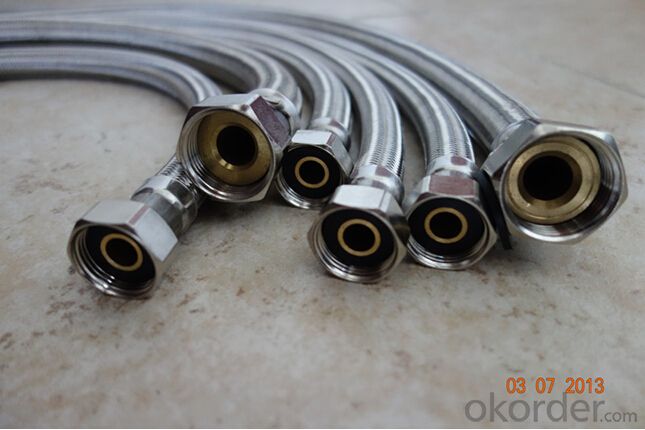
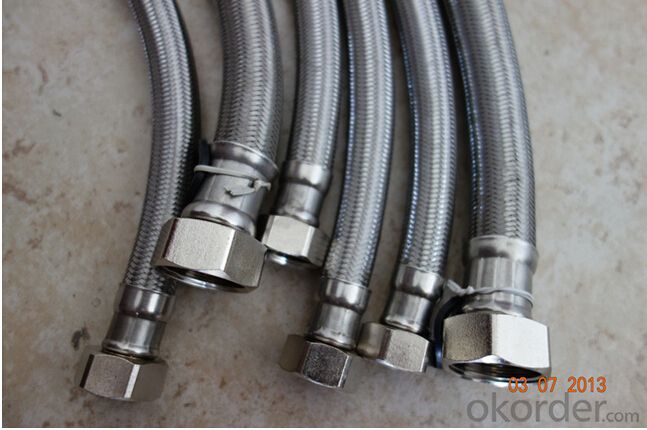
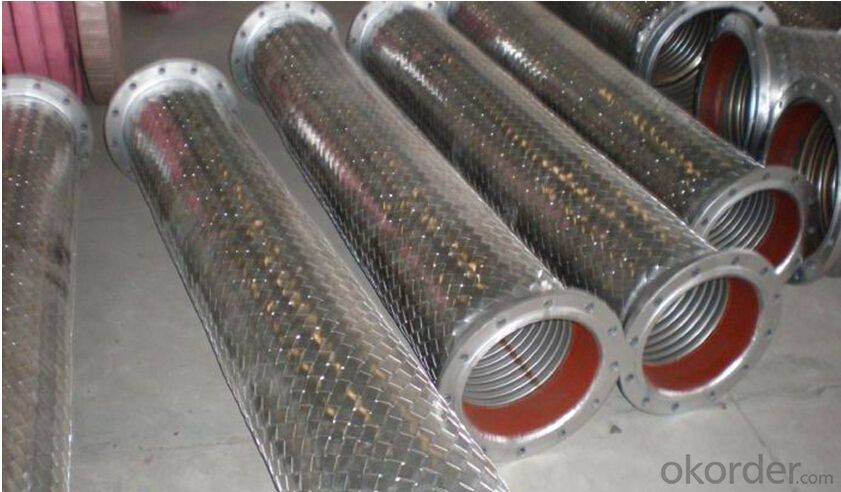
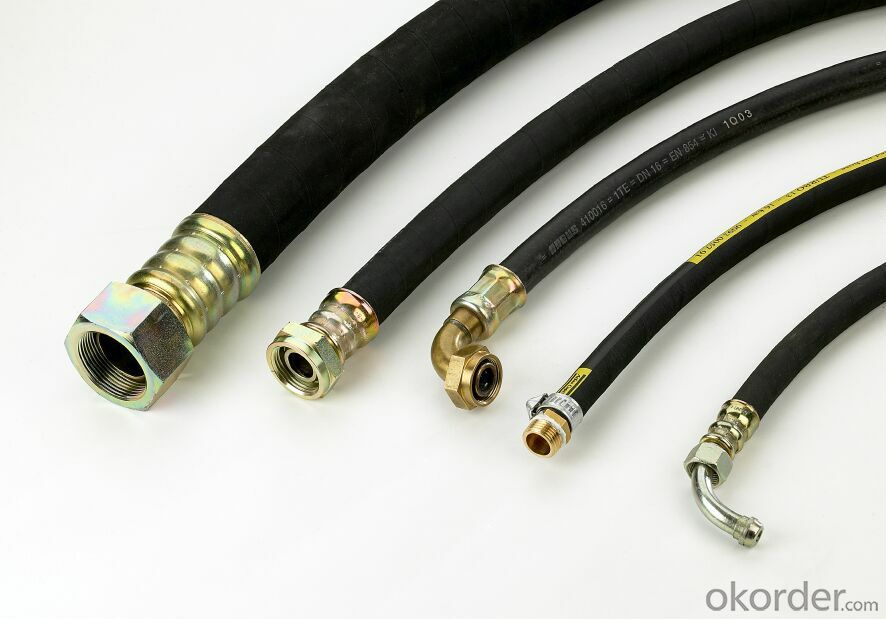
Package of Metal Hose in Stainless Steel for Gas Transportation:
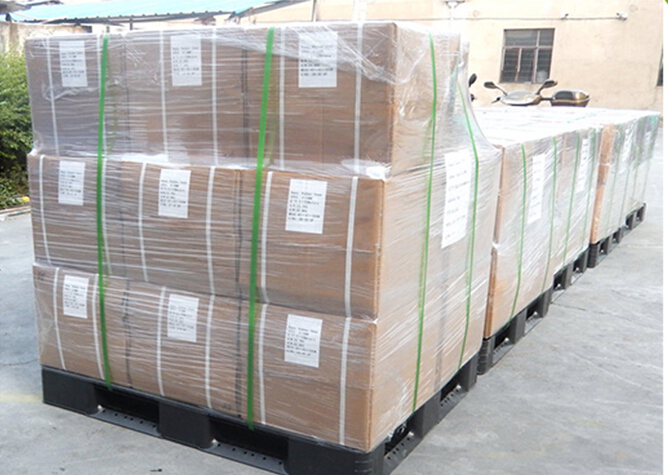
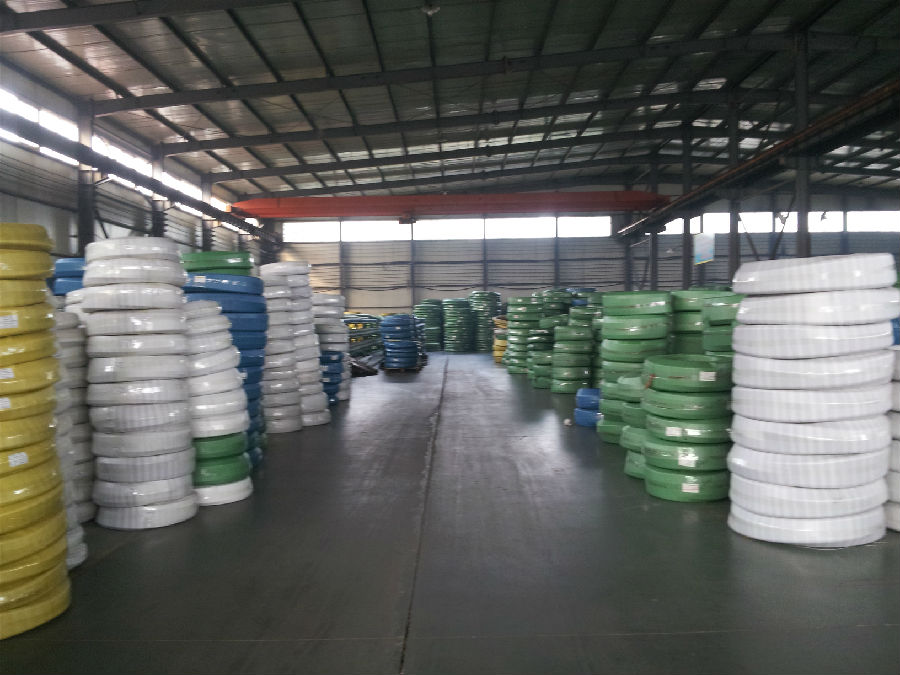
FAQ of Metal Hose in Stainless Steel for Gas Transportation:
Who we are:
Answer: We CNBM is a Chinese state-owned enterprise ranked 267th among the Global Fortune 500, as the largest building materials company,we have over 300 affiliated companies,and so many production lines and branch office distribute in China.
2. About our quality:
Answer: Every product needs to be quality proved before shipping.
3. About our service:
Answer: We could gurantte that we can reply you in 2 working hours.
- Q:Can stainless steel pipes be painted or coated?
- Indeed, it is possible to paint or coat stainless steel pipes. However, it is vital to opt for a suitable paint or coating specifically formulated for stainless steel surfaces. This is because stainless steel possesses a smooth and non-porous surface, which can pose a challenge for proper adherence of paint or coatings. Moreover, stainless steel pipes may encounter harsh environmental conditions, such as elevated temperatures or corrosive substances, thus necessitating the use of a paint or coating that is resistant to these elements. By selecting the appropriate paint or coating and employing correct surface preparation techniques, one can effectively enhance the appearance of stainless steel pipes or provide them with added protection against corrosion.
- Q:How are stainless steel pipes graded?
- Stainless steel pipes are graded based on their composition, strength, and corrosion resistance. The grading system, commonly known as the "SAE steel grades," categorizes stainless steel pipes into different series such as 200, 300, and 400 series. These grades are determined by the amount of chromium and nickel present in the steel, which enhances its resistance to corrosion. Additionally, stainless steel pipes can also be classified by their dimensions, specifications, and designated applications.
- Q:How do you prevent clogging in stainless steel pipes?
- To prevent clogging in stainless steel pipes, there are several measures that can be taken: 1. Regular maintenance: It is important to perform regular maintenance on stainless steel pipes to prevent clogging. This includes periodic inspection and cleaning to remove any build-up or debris that may lead to blockages. 2. Proper disposal of waste: Ensure that only appropriate materials are disposed of in the pipes. Avoid flushing or introducing items such as paper towels, sanitary products, or grease down the drain, as these can accumulate and cause clogs. 3. Use drain filters: Install drain filters or strainers at the openings of the pipes to catch any large particles or debris that could potentially cause clogs. These filters can be cleaned regularly or replaced as needed. 4. Avoid corrosive materials: Some chemicals or substances can corrode stainless steel pipes, leading to damage and potential clogs. It is important to avoid using corrosive materials in or near the pipes and to follow manufacturer guidelines for chemical usage. 5. Proper water flow: Ensure that there is adequate water flow through the pipes to prevent clogging. This can be achieved by running water regularly, especially for pipes that are not frequently used. 6. Consider water softeners: If the water supply is particularly hard, it may contain minerals that can build up and eventually clog the pipes. Installing a water softener can help reduce mineral deposits and prevent clogs. 7. Seek professional help: If you experience persistent clogging or are unsure of how to prevent it, it is recommended to consult with a professional plumber. They can assess the situation, provide guidance on preventive measures, and address any existing clogs effectively. By following these preventive measures, you can minimize the risk of clogs in stainless steel pipes and ensure the smooth operation of your plumbing system.
- Q:Can stainless steel pipes be used for gas applications?
- Indeed, gas applications can utilize stainless steel pipes. Thanks to their remarkable resistance to corrosion and ability to endure elevated temperatures, stainless steel proves an ideal material for gas transportation. Moreover, these pipes boast exceptional strength and durability, instilling confidence in the safety and dependability of the gas system. Consequently, they find widespread use in industrial, commercial, and residential settings where gas transport is necessary. Nonetheless, it remains crucial to verify that the stainless steel pipes employed meet the precise criteria and standards for gas applications, guaranteeing optimal installation and performance.
- Q:How do you calculate the expansion and contraction of stainless steel pipes?
- To calculate the expansion and contraction of stainless steel pipes, you need to consider the coefficient of thermal expansion (CTE) of the material and the change in temperature. The formula for calculating the thermal expansion or contraction of a stainless steel pipe is: ΔL = L * CTE * ΔT Where: ΔL is the change in length of the pipe L is the original length of the pipe CTE is the coefficient of thermal expansion of stainless steel ΔT is the change in temperature By plugging in the values for length, CTE, and temperature change into this formula, you can determine the expansion or contraction of the stainless steel pipe.
- Q:How do stainless steel pipes compare to titanium pipes?
- Stainless steel pipes and titanium pipes exhibit distinct characteristics, catering to diverse applications based on specific needs. In terms of strength, titanium pipes generally outperform stainless steel pipes. Titanium possesses an impressive strength-to-weight ratio, making it an ideal choice for lightweight yet strong materials. Conversely, stainless steel is renowned for its excellent tensile strength and durability, albeit being relatively heavier than titanium. Regarding corrosion resistance, both stainless steel and titanium pipes demonstrate high resistance to corrosion. Nevertheless, titanium pipes offer superior corrosion resistance, particularly in aggressive environments like seawater or chemical processing applications. Stainless steel pipes also possess good corrosion resistance but might require additional coatings or treatments to enhance their resistance in certain conditions. Temperature resistance is another crucial aspect to consider. Titanium pipes can endure high temperatures without compromising their strength or structural integrity, making them suitable for high-temperature applications in industries such as aerospace or power generation. Stainless steel pipes also exhibit decent heat resistance, but their performance may vary depending on the specific grade of stainless steel and the temperature range involved. Cost is an essential factor as well. Generally, stainless steel pipes are more cost-effective compared to titanium pipes. Titanium, due to its scarcity, intricate fabrication process, and higher production costs, is a pricier material. Hence, if cost is a significant consideration, stainless steel pipes emerge as a more viable option. In conclusion, stainless steel pipes and titanium pipes possess their own merits and aptitude for distinct applications. Titanium pipes excel in terms of strength, corrosion resistance, and heat resistance but come at a higher cost. Stainless steel pipes offer satisfactory strength, corrosion resistance, and cost-effectiveness. Ultimately, the selection between the two relies on the specific requirements, budget, and intended application of the pipes.
- Q:Are stainless steel pipes suitable for high-pressure steam applications?
- Yes, stainless steel pipes are suitable for high-pressure steam applications. Stainless steel is known for its excellent corrosion resistance, high temperature resistance, and strength, making it an ideal material for handling high-pressure steam. The pipes' ability to resist corrosion ensures that they can withstand the harsh conditions and prevent any leakage or failure. Additionally, stainless steel pipes can handle high temperatures without deforming or weakening, ensuring the safe and efficient transfer of steam. Overall, stainless steel pipes are a reliable choice for high-pressure steam applications due to their durability, corrosion resistance, and ability to withstand high temperatures.
- Q:Are stainless steel pipes suitable for water treatment plants?
- Indeed, water treatment plants find stainless steel pipes to be a fitting choice. Stainless steel possesses resistance against corrosion, enabling it to endure the harsh circumstances commonly present within water treatment plants, such as exposure to chemicals, high temperatures, and high pressure. Moreover, its durability is exceptional, guaranteeing an extended lifespan and diminishing the necessity for frequent replacements. The smooth inner surface of stainless steel pipes further prevents the accumulation of deposits and enhances the efficiency of water flow. Furthermore, stainless steel upholds hygienic standards and refrains from leaching harmful substances into the water, thus ensuring the quality and safety of the treated water.
- Q:304 stainless steel seamless tube weight how to calculate?
- 304 stainless steel is a common stainless steel material, the density of 7.93 g/cm3, the industry is also called 18/8 stainless steel. High temperature resistance of 800 degrees, with good processability, high toughness characteristics, widely used in industry and furniture decoration industry and food and medical industry.
- Q:How do you clean stainless steel pipes?
- To effectively clean stainless steel pipes, various methods can be employed depending on the extent of dirt or grime present. To begin with, warm water and a mild detergent can be utilized. The detergent should be mixed with water and a soft cloth or sponge can be used to gently wipe the surface of the pipes. It is important to ensure that the wiping motion follows the direction of the grain in order to prevent any scratching of the steel. Following this, the pipes should be thoroughly rinsed with clean water and dried with a clean, lint-free cloth. In cases where the pipes exhibit tougher stains or buildup, a vinegar solution can be employed. Equal parts of vinegar and water should be mixed and the resultant solution can be applied to the pipes. Allowing it to sit for a few minutes will enable the solution to dissolve the stains, after which a soft brush or cloth can be used to gently scrub the pipes. Subsequently, the pipes should be well-rinsed with clean water and thoroughly dried. For more stubborn stains or discoloration, the utilization of a specialized stainless steel cleaner or polish is recommended. The product's instructions should be followed, typically involving its application to the pipes and subsequent rubbing with a soft cloth, once again following the direction of the grain. The pipes must then be rinsed extensively with clean water and completely dried. It should be noted that abrasive cleaners or scrubbing pads must be avoided as they possess the potential to scratch the stainless steel surface. Furthermore, it is advisable to always test any cleaning solution or product on a small, inconspicuous area of the pipes before applying it to the entire surface. This ensures that no damage or discoloration occurs.
1. Manufacturer Overview |
|
|---|---|
| Location | |
| Year Established | |
| Annual Output Value | |
| Main Markets | |
| Company Certifications | |
2. Manufacturer Certificates |
|
|---|---|
| a) Certification Name | |
| Range | |
| Reference | |
| Validity Period | |
3. Manufacturer Capability |
|
|---|---|
| a)Trade Capacity | |
| Nearest Port | |
| Export Percentage | |
| No.of Employees in Trade Department | |
| Language Spoken: | |
| b)Factory Information | |
| Factory Size: | |
| No. of Production Lines | |
| Contract Manufacturing | |
| Product Price Range | |
Send your message to us
Metal Hose in Stainless Steel for Gas Transportation
- Loading Port:
- Tianjin
- Payment Terms:
- TT OR LC
- Min Order Qty:
- 1000 pc
- Supply Capability:
- 100000 pc/month
OKorder Service Pledge
OKorder Financial Service
Similar products
New products
Hot products
Related keywords






























